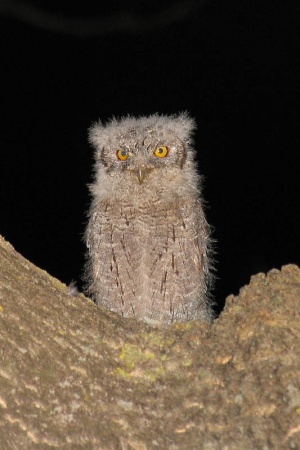(C/right. References updated) |
(Picture of Cyprus Scops Owl. Dictionary links. References updated) |
||
| Line 1: | Line 1: | ||
| + | [[Image:Common_Scops_Owl.jpg|thumb|550px|right|Photo © by {{user|JJM|JJM}} <br />[[Lesvos]], May 2003]] | ||
'''Alternative names: Commmon Scops-Owl; European Scops-Owl''' | '''Alternative names: Commmon Scops-Owl; European Scops-Owl''' | ||
| − | + | ||
;[[:Category:Otus|Otus]] scops | ;[[:Category:Otus|Otus]] scops | ||
'''Includes: Cyprus Scops Owl''' | '''Includes: Cyprus Scops Owl''' | ||
| Line 6: | Line 7: | ||
[[Image:41077skovik3.JPG|thumb|300px|right|Juvenile<br />Photo © by {{user|anzek|anzek}}<br />Bijela, [[Montenegro]]]] | [[Image:41077skovik3.JPG|thumb|300px|right|Juvenile<br />Photo © by {{user|anzek|anzek}}<br />Bijela, [[Montenegro]]]] | ||
16–20 cm (6¼-7¾ in)<br /> | 16–20 cm (6¼-7¾ in)<br /> | ||
| − | Small, eared owl with yellow eyes. | + | Small, eared owl with yellow eyes.<br /> |
| + | Plumage is a grey-buff intricately marked with black, which provides excellent camouflage against tree bark when roosting. | ||
| − | Young birds are more strongly vermiculated than adults. | + | Young birds are more strongly [[Dictionary_T-Z#V|vermiculated]] than adults. |
==Distribution== | ==Distribution== | ||
Southern [[Europe]], parts of North [[Africa]], [[Asia Minor]] east to Central [[Asia]]. Many populations migratory, moving to [[Africa]] south of Sahara in winter. | Southern [[Europe]], parts of North [[Africa]], [[Asia Minor]] east to Central [[Asia]]. Many populations migratory, moving to [[Africa]] south of Sahara in winter. | ||
==Taxonomy== | ==Taxonomy== | ||
| − | Originally formed superspecies with [[Oriental Scops Owl]] and [[African Scops Owl]] but is vocally and genetically distinct. | + | Originally formed [[Dictionary_P-S#S|superspecies]] with [[Oriental Scops Owl]] and [[African Scops Owl]] but is vocally and genetically distinct. |
====Subspecies==== | ====Subspecies==== | ||
| + | [[Image:Cyprus Scops Owl Sample 1.jpg|thumb|300px|right|Cyprus Scops Owl<br />Photo © by {{user|ApusApus|ApusApus}}<br />Paphos District, [[Cyprus]], 22 February 2020]] | ||
Six subspecies are recognized<sup>[[#References|[1]]]</sup>: | Six subspecies are recognized<sup>[[#References|[1]]]</sup>: | ||
*''O. s. scops'': | *''O. s. scops'': | ||
| Line 40: | Line 43: | ||
''[[Media:Otus scops (song).mp3|Listen in an external program]]'' | ''[[Media:Otus scops (song).mp3|Listen in an external program]]'' | ||
==References== | ==References== | ||
| − | #{{Ref- | + | #{{Ref-Clements6thAug19}}#{{Ref-GillDonsker16V6.3}} |
{{ref}} | {{ref}} | ||
==External Links== | ==External Links== | ||
{{GSearch|Otus_Scops}} | {{GSearch|Otus_Scops}} | ||
[[Category:Birds]][[Category:Otus]][[Category:Bird Songs]] | [[Category:Birds]][[Category:Otus]][[Category:Bird Songs]] | ||
Revision as of 21:52, 27 February 2020
Alternative names: Commmon Scops-Owl; European Scops-Owl
- Otus scops
Includes: Cyprus Scops Owl
Identification
16–20 cm (6¼-7¾ in)
Small, eared owl with yellow eyes.
Plumage is a grey-buff intricately marked with black, which provides excellent camouflage against tree bark when roosting.
Young birds are more strongly vermiculated than adults.
Distribution
Southern Europe, parts of North Africa, Asia Minor east to Central Asia. Many populations migratory, moving to Africa south of Sahara in winter.
Taxonomy
Originally formed superspecies with Oriental Scops Owl and African Scops Owl but is vocally and genetically distinct.
Subspecies
Six subspecies are recognized[1]:
- O. s. scops:
- France and Mediterranean islands to Volga River, northern Greece and Transcaucasia
- O. s. pulchellus:
- Volga River to Lake Baikal and south to Altai and Tien Shan Mountains
- O. s. mallorcae:
- Iberian Peninsula, Balearic Islands, northern Morocco, Algeria and Tunisia
- O. s. cycladum:
- O. s. cyprius:
- Cyprus - split by IOC as Cyprus Scops Owl
- O. s. turanicus:
Subspecies cycladum may be included in nominate form.
Habitat
Open or semi-open woodland, parks, plantations etc. Winters on savannah. Usually not conifers except in parts of Russian range.
Behaviour
Breeding
Nests in tree-holes and in cavities in rocks and walls.
Diet
Mainly insects and other invertebrates but also small lizards, frogs and small mammals.
Vocalisation
<flashmp3>Otus scops (song).mp3</flashmp3>
Listen in an external program
References
- Clements, J. F., T. S. Schulenberg, M. J. Iliff, S. M. Billerman, T. A. Fredericks, B. L. Sullivan, and C. L. Wood. 2019. The eBird/Clements Checklist of Birds of the World: v2019. Downloaded from http://www.birds.cornell.edu/clementschecklist/download/
- Gill, F and D Donsker (Eds). 2016. IOC World Bird Names (version 6.3). Available at http://www.worldbirdnames.org/.
Recommended Citation
- BirdForum Opus contributors. (2024) Eurasian Scops Owl. In: BirdForum, the forum for wild birds and birding. Retrieved 5 May 2024 from https://www.birdforum.net/opus/Eurasian_Scops_Owl






